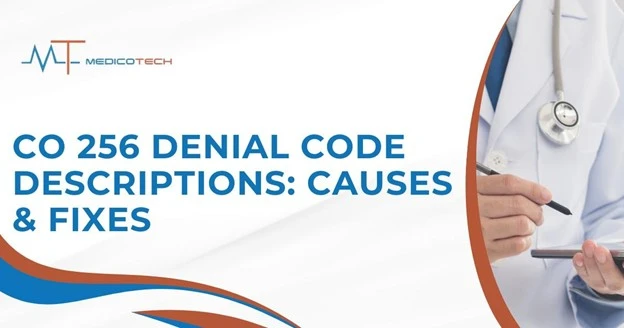The medical billing profession requires healthcare providers and medical professionals to handle multiple denial code types when carrying out their work. CO 256 Denial Code stands as a widespread refusal among medical agencies. Medical practices can prevent payment delays by understanding CO 256 denial codes and implementing proper handling procedures to avoid such issues in billing operations.The following discussion focuses on CO 256 Denial Code as we analyze its underlying factors leading to this issue and present the correct resolution strategy along with measures to stop future occurrences. This extensive document provides professional medical bills coders and healthcare institutions with proven strategies to handle CO 256 denial cases.
What is CO 256 Denial Code?
During claims adjudication insurance companies frequently deliver the CO 256 Denial Code as one among their standard rejection notices. A claim rejected by an insurance company becomes CO 256.when the insurance company decides the provided services do not meet the criteria for reimbursement through issues related to provider agreements and treatment services.
A healthcare provider should react quickly upon receiving a CO 256 Denial Code. Medical insurance companies issue this denial code when they detect one of various reasons which include wrong interpretation of policies or improper coding and failure to meet specific contractual requirements.
The solution to solve this payment denial requires the identification of original error sources and implementation of appropriate corrections to prevent correct payment processing.
Common Causes of CO 256 Denial Code
Healthcare professionals must identify the original factors that trigger CO 256 denials as the initial step to solve this challenge. The following list includes the main triggers responsible for this denial process.
1. Provider Network Issues
The major reason behind CO 256 denials occurs because the healthcare provider does not participate within the patient’s insurance network. A policy that only allows in-network providers will reject all claims sent to out-of-network providers through CO 256 denial.
Using insurance credentialing services can help ensure that the provider is properly listed within the network, reducing the likelihood of network-related denials.
2. Incorrect or Missing Information
The existence of wrong or omitted data in claims leads to significant CO 256 denial incidents. A denial with CO 256 code can occur when any part of patient information is missing or when claim form coding contains inaccuracies.
3. Non Covered Services
Insurance companies maintain particular rules about what procedures and services their members can claim payment for. The claim will receive a CO 256 denial code when the insurance plan fails to cover the provided services. The claim denial using CO 256 will apply to optional procedures alongside additional non mandatory services.
4. Authorization and Pre certification Issues
Insurance plans demand their members to obtain pre authorization or pre certification before their providers conduct specific procedures or provide health services.
A provider who provides the medical billing services without proper prior authorization will face claim rejection by insurance companies which results in CO 256 denial code.
5. Billing for Services Already Provided
The CO 256 denial may occur when the insurance company receives payment or gets billed for theservices before the healthcare provider rendered them. A claim denial occurs when insurers discover duplicate service requests because they will not pay for anything that has been presented multiple times.
6. Unmet Policy Requirements
The healthcare service delivery under insurance policies needs to fulfill particular specifications that providers must follow. The insurance policy sets certain conditions including maximum visit limits and pre defined practice standards for service delivery. The requirements stated in policies must be followed to avoid CO 256 denials.
7. Out of Date Information
Healthcare providers will receive a CO 256 denial when their insurance contract expires or unless they receive proper notice of contract modifications.
8. Incorrect Coding
A misrepresentation of medical codes serves as one of the main triggers for CO 256 denials. All medical billing codes (CPT, ICD-10) need proper alignment since minor mistakes will trigger claim rejection.
How to Fix CO 256 Denial Code
In order to rectify a CO 256 denial the claim and all contributing denial factors must be thoroughly examined. Both below points serve as step-by-step action plans to address this particular issue:
1. Verify Provider Status
Ensure the healthcare provider’s membership is covered within the patient’s current network. Verify whether your insurance lets you obtain coverage from out of network providers while inspecting whether they offer status changes in their network.
2. Review Claim Information
Pure all aspects of the claim to verify their accuracy. The verification process should include correct information about patient demographics and insurance details together with provider details and service codes. Denials often result from mistakes occurring in these specified areas.
3. Ensure Services Are Covered
Verify that all offered services fall within the patient’s insurance coverage boundaries. Contact the patient about the denial while appealing it when extraordinary conditions exist.
4. Obtain Authorization
When insurance authorization serves as the rejection cause you need to submit requests for pre authorization and pre certification without delay to the insurance provider. Make sure all obligatory documents reach the insurer with no errors.
5. Correct Duplicate Claims
The provider must evaluate all previous submitted claims to eliminate any possible duplicates that caused the denial. The provider should fix incorrect duplicate claims before renewing the submission process.
6. Resolve Policy Requirement Issues
The insurance policy should be reviewed to check for policy requirements compliance when denial occurs. The provider needs to provide supporting documents or extra clarification to solve this denial.
7. Update Contract Information
The provider needs to contact the insurance company for updating or renewing an outdated contract which led to CO 256 denial. Check for recent updates across all involved details while verifying continuous policy protection.
8. Recheck Coding
Clinical staff should review both medical coding systems of CPT and ICD-10 to verify their accuracy against actual medical services performed. To fix such errors you should revise the code and send the claim again.
How to Avoid the CO 256 Denial Code
By taking preventative measures, a CO 256 denial can be avoided. Medical professionals can lessen the possibility that this denial would ever happen by adhering to established procedures. Here are a few ways to avoid this:
1. Keep Contracts Up to Date
Verify the currentness of all provider agreements with insurance companies. Check for terms, renewals, and changes to network status or coverage on a regular basis.
2. Complete and True Statements
Before sending claims to the insurance company, be sure they are accurate and complete. This involves making certain that all relevant documents are included and that all appropriate fields are filled out.
3. Obtain Prior Permission
Always get the required approvals before performing any services that call for pre-authorization. All authorizations should be kept on file for convenient access in the event of a disagreement.
4. Remain in the Network
Make ensuring that services are rendered inside the patient’s insurance network wherever feasible. Provide patients with advance notice of any possible out-of-pocket expenses or claim denials if they decide to receive care outside of their network.
5. Regular Staff Training
Regularly train your billing and coding staff to stay updated on coding standards and insurance requirements. Having a knowledgeable team can significantly reduce the chances of errors that lead to denials.
6. Keeping an eye on insurance policies
Pay attention to any modifications to insurance policies, since these could have an impact on service eligibility and coverage. Examine the payer’s policies on a regular basis to make sure that their rules are being followed.
7. Efficient Follow up System
Implement an efficient follow up system to track pending claims. If a claim is denied, it’s crucial to take prompt action and resubmit it as quickly as possible.
Real Life Examples of CO 256 Denial Scenarios
Two actual cases serve as examples to show when CO 256 rejection codes happen together with the appropriate solutions:
Example 1: Provider Network Issue
Dr. Smith’s office submits healthcare insurance documentation for a surgical operation to the financial processing department. A CO 256 denial code breaks down the claim which results in denial. The denial occurred because insurance network rules show Dr. Smith is not recognized by the patient’s plan. To resolve the issue one should reach out to the insurance provider for out of network benefit information or notify patients about out of network financial responsibility.
Example 2: Incorrect Coding
The hospital presents to the insurance company for reimbursement of diagnostic tests performed on their patients. The incorrect diagnostic code entered into the claim processing system results in CO 256 denial code. The health records are examined to determine the right ICD 10 code which allows claim submission with accurate data.
Impact of CO 256 on Claims and Revenue
Claims and total revenue face important financial repercussions because of CO 256 denials. Providers experience delays in payment along with elevated operational expenses whenever claims get denied because they must rework the claims. The increased number of claim denials results in reduced cash flow because practices need to spend additional time on resubmissions followed by interactions with insurance organizations.Ongoing CO 256 denials show a recurring billing process problem that creates long lasting operational issues while possibly reducing practice revenue potential. The resolution of CO 256 denials must happen swiftly along with preventive measures because these actions ensure the stability of your revenue cycle system.
Conclusion
The CO 256 Denial Code appears frequently in medical billing practice, yet healthcare providers can address it successfully through proper knowledge of its response mechanics and prevention strategies. The streamlined operation of billing processes, faster cash flow, and timely reimbursement come from medical providers who know root causes and take proper preventive measures to avoid future errors and implement denial resolution methods. Your claims must always be precise, complete, and in full insurance compliance to reduce claim denial probability.
MedicoTech provides professional medical billing services and insurance credentialing services, ensuring your practice has the support needed for accurate and efficient claim submissions. By optimizing your revenue cycle, we help you avoid the uncertainty that comes with denials such as the CO 50 Denial and CO 256 Denial.
FAQs About CO 256 Denial Code
Q1: What does the CO 256 denial code mean? The CO 256 denial code means that the insurance company has determined that the claim is not eligible for reimbursement, typically due to network issues, incorrect coding, or policy restrictions.
Q2: How can I resolve a CO 256 denial? To resolve a CO 256 denial, review the claim for accuracy, ensure the provider is in-network, check for authorization requirements, and correct any coding errors before resubmitting the claim.
Q3: How can I prevent CO 256 denials in the future? Preventing CO 256 denials involves ensuring
accurate claims submission, maintaining updated contracts, staying informed about insurance policies, obtaining pre authorizations, and providing services within network coverage.
Q4: Can CO 256 denials be appealed? Yes, CO 256 denials can be appealed if you believe the denial was issued in error. Provide supporting documentation to the insurance company to support your claim.




